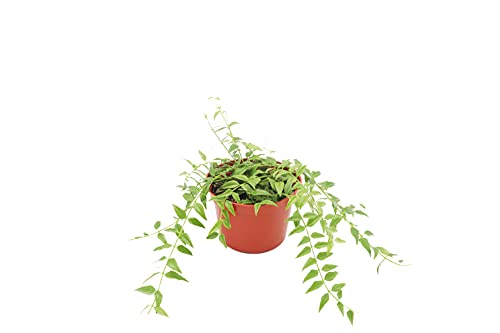Hoya plants, commonly known as wax plants, are beloved for their unique foliage and fragrant flowers. Belonging to the Apocynaceae family, these tropical plants originate from Southeast Asia and can be found in a variety of habitats, from the lush rainforests to the humid jungles. With their succulent-like leaves and waxy texture, hoyas have become popular houseplants for enthusiasts around the world. In this beginner’s guide, we’ll explore 15 different species of hoyas, their native habitats, growing conditions, and proper care for keeping these indoor plants.
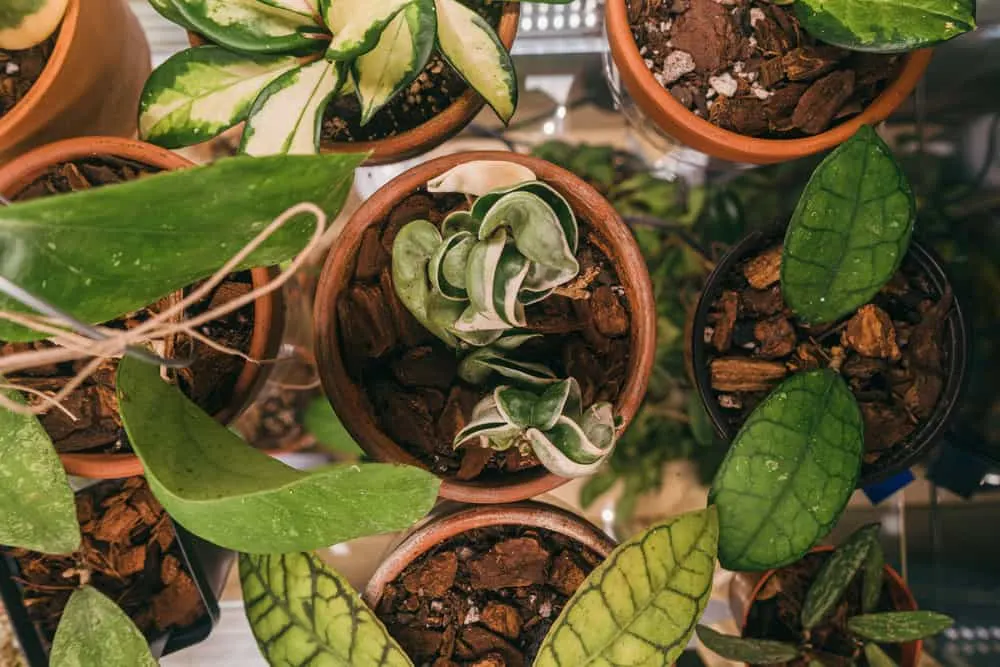
contains affiliate links
1. Hoya Australis – Native to Australia, Hoya australis is characterized by its oval leaves and small clusters of white flowers. It thrives in bright, indirect light and high humidity, making it a perfect addition to any indoor garden.
2. Hoya Bella – With its narrow leaves and porcelain flowers, Hoya bella is a charming species. Its delicate blooms emit a sweet fragrance, adding a touch of beauty to any space.
3. Hoya Kerrii – Also known as the sweetheart hoya, Hoya kerrii features heart-shaped leaves and pink flowers. It is one of the easiest hoyas to care for, requiring minimal water and thriving in low light conditions.
Note: When you buy h. kerrii as just the heart shaped leaf in soil, more commonly around Valentine’s Day, it probably will not grow beyond that. Some people report that it grows into a full plant, but it’s not often. If you want to grow a larger plant and not just keep a leaf alive, make sure you are buying a Kerrii with a rooted stem system.
4. Hoya Linearis – Hoya linearis stands out for its long, narrow leaves and star-shaped blooms. This species prefers bright, indirect light and regular watering during the growing period in late spring and summer.
5. Hoya Pubicalyx – Hoya pubicalyx is prized for its dark green foliage and red-centered flowers. It requires bright, indirect light and high humidity to thrive, making it a stunning addition to any hoya collection.
6. Hoya Obovata – Featuring thick, waxy leaves and white variegation, Hoya obovata is a striking species. Its star-shaped flowers add a touch of elegance to any space.
7. Hoya Carnosa – One of the most popular species of hoya, Hoya carnosa is known for its glossy leaves and fragrant flowers. It can tolerate a wide range of conditions but prefers bright, indirect light and regular watering. If you are looking for the easiest hoya to add to your houseplant collection, h. carnosa is a popular pick for good reason.
8. Hoya Wayetii – Hoya wayetii is prized for its succulent-like leaves and unique foliage.
9. Hoya Caudata – Hoya caudata features thick, waxy leaves and small clusters of white flowers. It requires high humidity and indirect light to thrive.
10. Hoya Retusa – With its thin, elongated leaves and star-shaped flowers, Hoya retusa is a striking species. Its unique foliage adds a touch of beauty to any space.
11. Hoya Curtisii – Hoya curtisii is prized for its fleshy leaves and star-shaped blooms.
12. Hoya Krimson Princess – Featuring green leaves with white variegation, Hoya krimson princess is a stunning cultivar of Hoya carnosa.
13. Hoya Krimson Queen – Similar to Hoya krimson princess, Hoya krimson queen features green leaves with white variegation.
14. Hoya Lacunosa – With its heart-shaped leaves and fragrant flowers, Hoya lacunosa is a delightful addition to any indoor garden.
15. Hoya Crassipetiolata – This hoya is known for its growth and beautiful vining ability.
I have always loved perusing the different garden centers of big box stores like Walmart, Home Depot, and Lowe’s, and am pleased to see that with each passing year, I find more and more different varieties of houseplants, including these types of hoya and even hybrids of hoya. I remember the first time I saw a Hoya Hindu rope plant (Hoya Carnosa Compacta) at Home Depot. I didn’t buy it, but it was fun to locate!
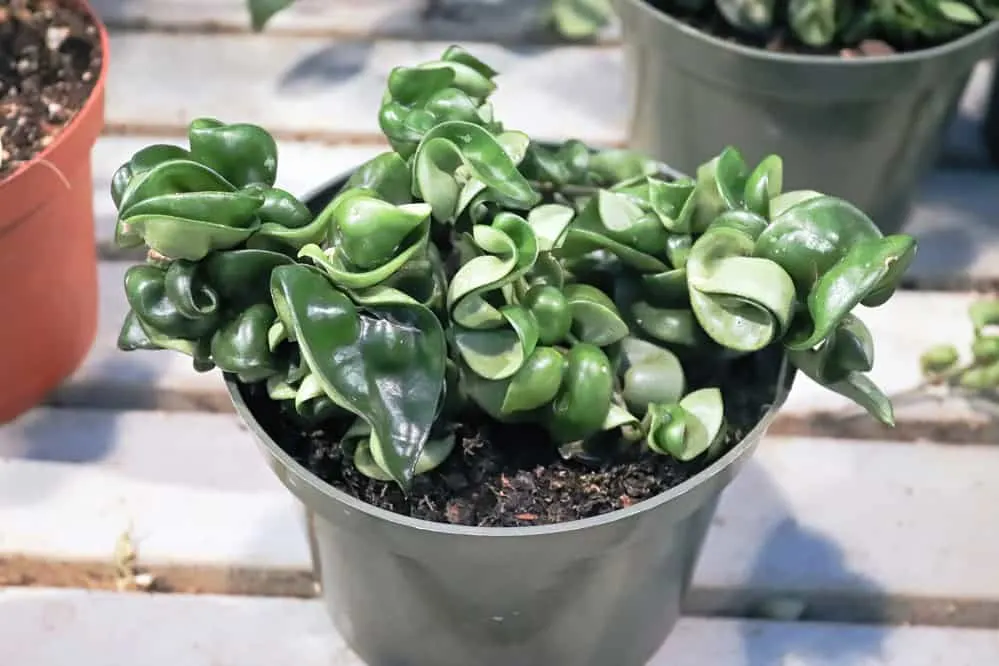
Hoya Hindu Rope – Hoya Carnosa Compacta
Hoya Plant Care
Caring for Hoya plants involves attention to their specific needs, which can vary depending on the species and cultivar. Keep in mind that most Hoya plants are slow growing, as are the blooming of the hoya flowers.
Here are some general tips to help you care for your Hoya plants:
- Light: Provide bright, indirect light for most Hoya species. Avoid direct sunlight, especially during the hottest parts of the day, as it can scorch the leaves. However, some species, like Hoya linearis and Hoya wayetii, can tolerate slightly lower light levels.
- Watering: Hoyas prefer to dry out slightly between waterings. Water thoroughly when the top inch of soil feels dry to the touch, but be cautious not to overwater, as this can lead to root rot. Some Hoya experts wait until the leaves wrinkle or pucker to water. Reduce watering during the winter months when growth slows down.
- Humidity: Maintain high humidity levels, especially for species like Hoya pubicalyx and Hoya kerrii, which are native to humid environments. You can increase humidity by placing a tray of water with pebbles beneath the plant or by using a humidifier.
- Temperature: Keep your Hoya plants in a warm environment, ideally between 60°F to 80°F (15°C to 27°C). Avoid exposing them to drastic temperature fluctuations or cold drafts, as this can stress the plants.
- Soil: Use a well-draining soil mix, such as a combination of peat moss, perlite, and orchid bark. Hoyas prefer soil that allows excess water to drain freely, preventing waterlogging and root rot.
- Potting: Repot your Hoya plants when they outgrow their containers. Choose a pot that is slightly larger than the current one and ensure it has drainage holes at the bottom.
- Fertilizing: Feed your Hoya plants with a balanced, water-soluble hoya fertilizer. Reduce or eliminate fertilization during the winter months when growth slows down.
- Pruning: Prune your Hoya plants as needed to remove dead or damaged foliage, encourage bushier growth, and control their size. You can also propagate new plants from stem cuttings taken during pruning.
- Support: Some Hoya species, like Hoya carnosa and Hoya curtisii, are vining plants that benefit from support structures such as trellises or stakes. Train the vines to climb or trail as desired to enhance their ornamental appeal.
- Pest control: Keep an eye out for common pests such as aphids, mealybugs, and spider mites, which can infest Hoya plants. Treat infestations promptly with insecticidal soap or neem oil, and isolate affected plants to prevent spreading.
By following these tips and paying attention to the specific needs of your Hoya plants, you can ensure they thrive and continue to beautify your indoor space for years to come.
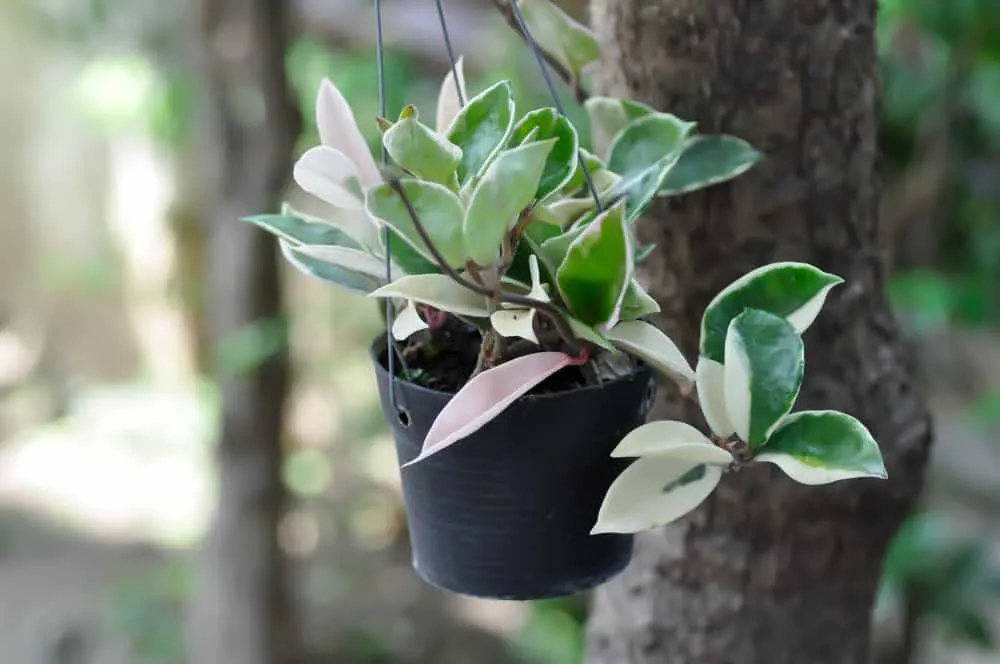
When will my hoya bloom?
The timing of when your Hoya plant will bloom depends on various factors, including its species, growing conditions, and maturity. Here are some general guidelines to help you determine when your Hoya might bloom:
- Species: Different species of Hoya have different blooming patterns. Some species bloom more readily and frequently than others. For example, Hoya carnosa is known for its prolific and fragrant blooms, while other species may bloom less frequently.
- Growing Conditions: Providing optimal growing conditions can encourage your Hoya plant to bloom. Ensure your plant receives bright, indirect light, as this is essential for flowering. Additionally, maintaining consistent watering, humidity, and temperature levels can help stimulate blooming.
- Maturity: Hoya plants typically need to reach a certain level of maturity before they start blooming. This can vary depending on the species and individual plant, but it’s not uncommon for Hoya plants to take several years to mature and produce flowers.
- Season: Many Hoya species bloom in response to changes in daylight length and temperature. While some species may bloom year-round in favorable conditions, others may have specific blooming seasons. For example, Hoya carnosa often blooms in late spring or early summer.
- Environmental Cues: Some Hoya species may require specific environmental cues to initiate flowering. A period of cooler temperatures or a slight reduction in watering can trigger blooming in certain species.
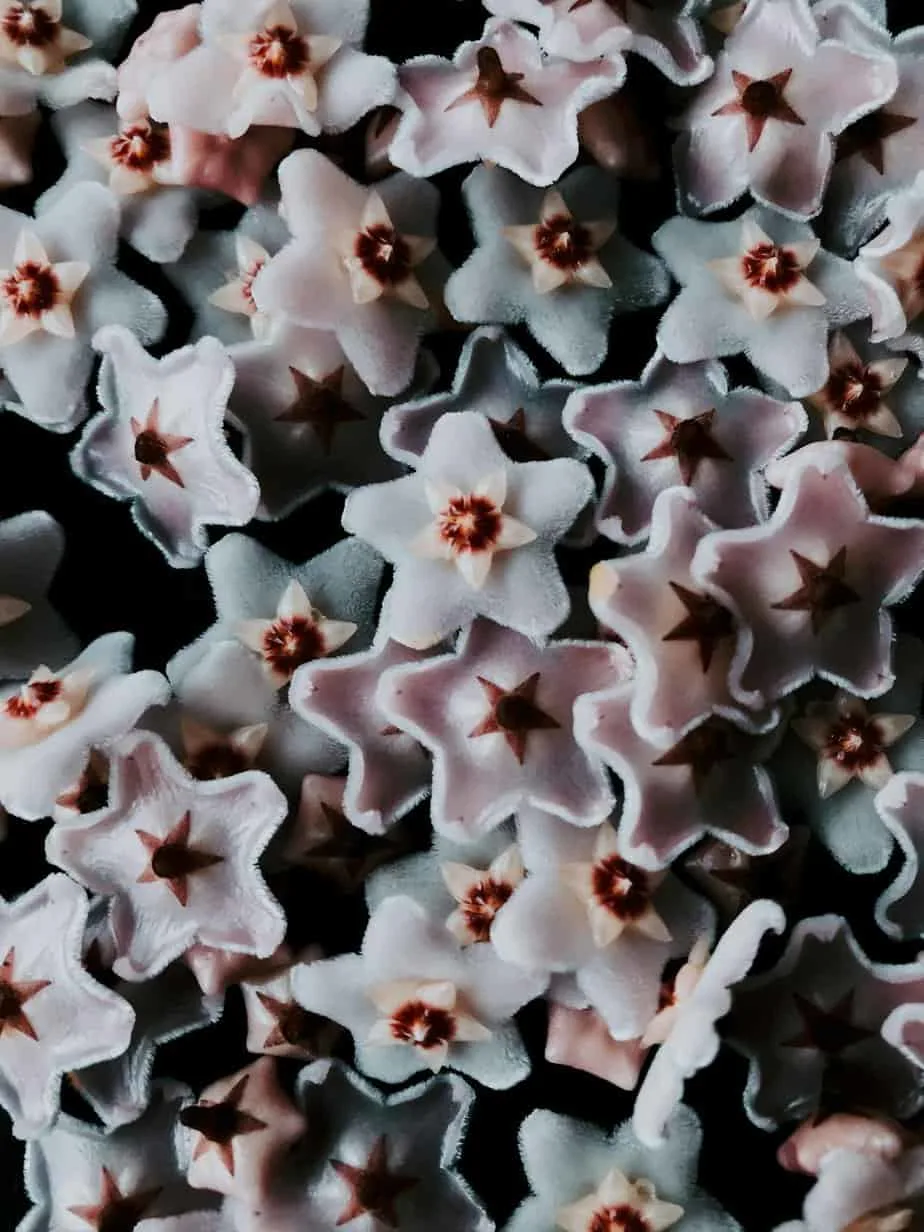
Photo by Agnese Lunecka
If your Hoya plant is healthy and well-established but has not yet bloomed, be patient and continue to provide it with proper care. With time and the right conditions, your Hoya will likely reward you with beautiful blooms. If you’re unsure about the specific blooming habits of your Hoya species, consider researching or consulting with experienced growers for more information.
In conclusion, hoyas are versatile and beautiful plants that can thrive in a variety of conditions. Whether you’re a seasoned hoya enthusiast or a beginner looking to start your collection, there’s a species or cultivar out there for you. With the right care and attention to growing conditions, you can enjoy these stunning plants for years to come. Happy gardening!
Hoya Species Houseplants
Choose one...or more...of these gorgeous Hoya houseplants!
Hoya 'Australis'
Hoya Australis Lisa
Hoya Lanceolata 'Bella'
Hoya Kerrii
Hoya Linearis
Hoya 'Silver Splash' - Hoya pubicalyx
Hoya Obovata Splash
Hoya Retusa
Hoya Krimson Princess
Tricolor Hoya Krimson Queen
Hoya Carnosa Krinkle Wax Plant
Hoya Compacta aka Hoya Hindu Rope
Hoya Wayetii Variegated
Hoya Caudata Sumatra
Hoya Curtisii
Hoya Lacunosa Mint
Hoya Crassipetiolata
Hoya Variety Assortment Plant Set, Premium Set, Variegated Wayetii, Curtisii, Macrophylla, Linearis and more



